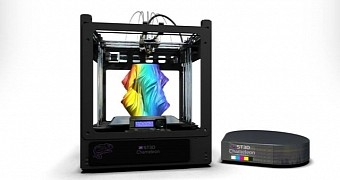3D printers can only make monochrome objects for the most part. Whether it is FDM, SLA or SLS technology, the results speak for themselves. Ironically, FDM printing lends itself more easily to multi-color production.
FDM, or fused deposition modeling, is the technique by which an object is created drop by drop from plastic, by driving a filament through a superheated extruder.
In the case of SLA (stereolithography), objects are grown from vats of resin by exposing said resin to ultraviolet light, curing it.
SLS, meanwhile, or selective laser sintering, exposes powdered materials to a laser. The powder is placed in a container and constantly replenished as the process goes on.
The reason FDM printing is the easiest to render into color is because it is possible to add more than one extruder to the contraption. This effectively increases the number of colors.
Add some material “magic” and you can create objects in full color if you know what you're doing. Something3D has just revealed a printer capable of it in fact.
The Something3D ST3D Chameleon
The ST3D Chameleon prints objects by combining Cyan, Magenta, Yellow, Black and White filaments. We’ll call this CMYBW method.
Interestingly, the printer does not actually use multiple extruders, but a single one, or at least a single nozzle.
Considering that multi-extruder/nozzle approaches usually only allow for multiple but clearly distinct colors to be mixed, this is definitely a step forward. The resolution can be of 0.5 mm per color change.
It is enough to make us hope that the product makes it beyond the borders of Israel as soon as possible, despite its price.
Availability
Shipments of the ST3D Chameleon 3D printer should have already begun in the company's home country, and we can only hope that other regions will receive it soon.
The price, sadly, is rather steep at $7,350 / €6,410, but the build volume is quite large (300 x 300 x 340 mm / 11.81 x 11.81 x 13.38 inches) and the print speed of 70 to 100 mm/s is good as well, especially with the 50 micron layer thickness. Deliveries will begin in 8 weeks.

 14 DAY TRIAL //
14 DAY TRIAL //